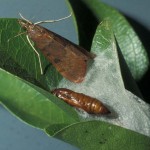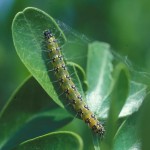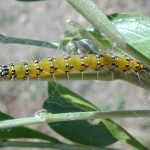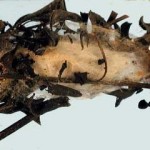The genista caterpillar, Uresiphita reversalis (Guenèe), is the immature stage of a moth (Lepidoprera: Pyralidae) that occurs on Texas mountain laurel, Sophora secundiflora, a small native tree sometimes used in the landscape (Drees and Jackman 1998).
Genista caterpillars occur commonly in central Texas landscapes and throughout the Gulf coast. They form loose webbing on the foliage and feed on leaves causing unsightly damage.
Plant health is generally unaffected by feeding unless large numbers of caterpillars cause heavy defoliation (leaf loss). In these cases, plant growth may be slowed and aesthetic damage may be significant. Control is generally unwarranted, but in some situations, such as commercial plant production in nurseries or heavy infestations in high-value landscapes, pest control or suppression may be desired.
Biology
Moths and butterflies have four distinct life stages. Larvae (caterpillars) emerge from eggs deposited by the adult female and go through several feeding stages (instars). Late in their development, larvae stop feeding and go into the pupal stage. Adults emerge from pupae to start the cycle once again.
In the case of the Genista caterpillar, winter is spent in the pupal stage and adult male and female moths emerge in early spring (Fig. 1). They are active at night when they mate and females lay overlapping clusters of cream colored eggs.
Leaves of Texas mountain laurel contain many secondary plant chemicals that protect plants against generalist herbivores. Genista caterpillars are immune to these chemicals and even benefit from them. Larvae can store and concentrate secondary chemicals in their bodies which makes them toxic to the most common natural enemies of other caterpillars. However, a few species of predaceous arthropods, such as spiders and assassin bugs, may feed on young caterpillars. These and parasitic insects (parasitoids) may help keep their populations in check.
Management
Plants, especially small Texas mountain laurel trees, should be checked frequently during the spring to detect egg masses. These are not easily found but are visible. Look for small batches of eggs in overlapping clusters. Monitoring efforts should be focused on the newest growth because young leaves are preferred by larvae. Light infestations on a few plants or small plantings may be controlled by hand removal, using high-pressure water sprays or by pruning infested terminals. Control or suppression of heavy infestations on a large number of plants may require insecticide applications. For best results make foliar spray applications (liquid sprays to leaves) when small larvae first appear. There are a number of insecticide products available for control of “caterpillars” or “lepidopterous larvae” on ornamental trees and shrubs. Although many product labels contain a list of target species, the species “genista caterpillar” is generally not listed in the most widely available products because it is a pest of regional importance only.
Insecticide products containing Bacillus thuringiensis var. kurstaki (Bt) are best used when caterpillars are small (½ inch or less) and actively feeding on leaves. The active ingredient in Bt products is a caterpillar-specific toxin (deltatoxin) that acts as a stomach poison. Therefore it must be ingested by the larvae to be effective. As with any contact pesticide thorough spray coverage is essential, especially targeting both the upper and under side of new leaves on which caterpillars feed. Repeated applications may be necessary during periods of new growth flush because Bt products have short residual activity. As with any insecticide, read and closely follow all instructions provided on the product label.
Some of the more recently introduced insecticide products targeting caterpillars contain spinosad (including spinosyn A and spinosyn D). There are several product brands available to homeowners but Conserve® SC Turf and Ornamental is labeled for use in commercial nurseries and may be available to homeowners through specialty catalogs. Spinosad is a biologically derived insecticide and a contact product. It has longer residual action than Bt products. Some spinosad formulations are registered as organic by the Organic Materials Research Institute.
Other broad spectrum insecticide products are available to control caterpillars in ornamental plants. Insecticidal soaps (potassium salts of fatty acids) suffocate and cause water imbalance in small caterpillars bathed in the spray, but large caterpillars may be unaffected. Soap sprays have no long-lasting or residual effects once the spray dries on the plant surface. For larger caterpillars, products containing other active ingredients such as acephate, carbaryl, synergized pyrethrins or synthetic pyrethroids such as bifenthrin, cypermethrin, permethrin, may be more effective. These are contact insecticides with residual activity.
Rotate products with different modes of action to avoid insecticide resistance selection and to keep good products viable when multiple applications are required due to overlapping generations or multiple infestations over time.
Disclaimer: All pesticides are potentially hazardous to human health and the environment. As a pesticide user, you are legally required to read and carefully follow all directions and all safety precautions on the container label. Label instructions are subject to change, so read the label carefully before buying, using and disposing of any pesticide. Regardless of the information provided byAgriLifeExtension, always follow your product’s label. When in doubt about any instructions, contact your pesticide seller, or the manufacturer listed on the label, for clarification.
All pesticides should be stored in their original labeled containers and kept out of the reach of children. Never pour leftover pesticides down a storm drain or any other drain.
Authors
Bastiaan M. Drees and Carlos Bogran,
Extension Entomologists, Texas AgriLife Extension Service




